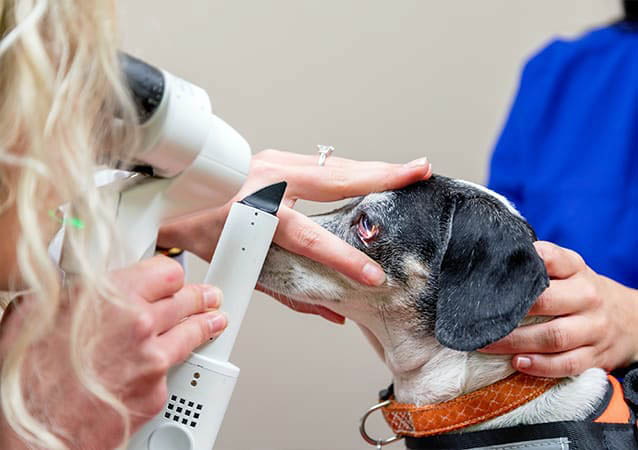The veterinary field is one that focuses on giving a medical diagnosis, treatment, and care to sick animals. A veterinarian is an animal doctor who performs diagnosis, surgery, and treatment to sick animals. On the other hand, a Veterinary Technician is a trained professional who does complimentary vet work alongside a Veterinarian.
A Veterinary Technician typically takes x-rays, vaccinates, and conduct blood tests. A Veterinary Assistant helps with the preparation of examination rooms, dressing wounds, restraining animals, cleaning medical tools, inoculating animals, and taking animal vital signs. To find out the salaries associated with these noble professions, keep reading our in-depth article.
Who is Veterinarian, aka Veterinary Surgeon?
A Veterinarian, as aforementioned, is the equivalent of a human’s General Practitioner for animals. Typically, a Veterinarian is a highly learned and qualified individual. To become a Veterinarian, one has to undergo many years of formal education.
To get the enviable title of a Veterinarian, one has first to complete a four-year undergraduate course after high school. After getting the first degree, one can then join a Veterinary Medicine program for another four years. This means that a Veterinarian has to have a minimum of eight years of undergraduate education to get a job. Most universities offer the Doctor of Veterinary Medicine degree. The bachelor’s degrees in this field include Bachelor of Veterinary Medicine, Bachelor of Veterinary Science, Bachelor of Veterinary Medicine and Surgery.
After completing the undergraduate program, a Veterinarian can choose to get an internship. Typically, a vet who starts his or her career with an internship earns more than those who choose not to get an internship. This is because internships increase the vet’s experience, which translates to a higher wage.

A Veterinary Surgeon usually performs operations on animals to treat conditions associated with hearts, bones, muscles, and the brain. A Veterinary Surgeon can also specialize in fields like oncology surgery, treating wounds and traumatic injuries, or joint surgery. To become a Veterinary Surgeon, one has to complete a degree in Veterinary Medicine and then complete a one-year internship. After that, the vet has to complete a three-year residency in a clinic or animal hospital. After the residency program, one then has to pass a board exam to start practicing.
Veterinarian Salary.
Veterinary Medicine is one of the better-paying professions in the U.S. The average pay of a vet in the U.S. is $90,500. The hourly average paid to vets is about $44. However, the pay differs from state to state and is also based on the level of education, years of experience, the field of specialization, and area of expertise.
The median starting salary for a vet who sees pet animals or companion animals is about $67,200. If a vet works with farm animals like cattle and sheep, the average starting salary is typically higher, about $76,700. A vet who attends only to horses starts out earning $47,800 annually.
A Veterinary Surgeon earns an average of $91,500 in the U.S. The starting salary is usually $44,000. However, it all depends on the state one is practicing in and the specialty of the surgeon. Some Veterinary Surgeons can earn over $160,000 annually. In fact, in the area of Lubbock, Texas, a vet earns an average salary of $228,500. The best paying states for Veterinarians are Virginia, Texas, California, Alaska, and New Jersey. The salary in each state also varies depending on the industry the vet works in. Managerial positions and consulting services are some of the best-paying ones. Typically, vets in these industries can make over $135,000. Scientific research and development pay from $111,000. On the other hand, clinics pay from $120,000.

The working hours per week for a vet are 40. However, a vet can be called in to attend to emergencies outside their working hours. However, it all a part of the job as saving lives comes first. The Veterinarian field is projected to continue growing as more than 16,000 new jobs are expected to be open by 2030. This represents a 20 percent growth making the field a highly marketable one. Besides, job security for the field is high.
Veterinary Technician Salary.
Veterinary Technicians give medical care to sick animals through carrying out blood sample testing, taking x-rays of sick animals, feed and clean animals, and administering vaccines. The Veterinary Technician field is easier to join as it doesn’t require many years of study like Veterinary Surgery or Medicine. All one needs is an associate’s degree in Veterinary Technology.
After completing the degree program, one has to pass a state exam to be certified to practice. However, a Veterinary Technologist studies two years more than a Veterinary Technician and is usually awarded a bachelor’s degree. The field is expected to continue growing in the next 10 years as more people get pets. So if you were contemplating joining the field, you can’t go wrong.
The average salary of a Veterinary Technician is about $31,000. On the other hand, a Veterinary Technologist’s average salary is about $38,500. Veterinary Technicians working in Universities, schools, and colleges earn higher than those who work in animal clinics. The former earn an average salary ranging from $40,000 to $49,000. The starting salary for a veterinary technician is about $27,880. Some of the best paying states for a Veterinary Technician are New York, Washington, Massachusetts, and New Hampshire. In these states, the average salary for Vet Technicians is about $34,000.
Veterinary Assistant Salary.
The Vet Assistant field is one of the easiest and most flexible practices in the veterinary field. Moreover, one doesn’t need an undergraduate certification to become a Veterinary Assistant. A high school diploma is all one needs, and the rest is learned on the job. Moreover, the vet assistant field is more flexible than a vet technician as there are options to work part-time.
Typically, a vet assistant helps a veterinarian around the clinic. They do a range of tasks like cleaning and feeding sick animals, cleaning medical tools, and other clerical tasks that they may be assigned. Due to the nature of their work, vet assistants need to be patient, loving, empathetic and also possess some degree of physical strength to help in restraining animals for procedures. Sick animals are usually distressed, and they could inflict injuries if they feel threatened. Thus, a vet assistant must always take all necessary precautions when handling animals to avoid bites, scratches, dangerous pecking, kicks, and other defense behaviors a sick animal may exhibit.
A vet assistant works in a range of industries such as clinics and animal hospitals, animal rescue centers, laboratories, and in learning institutions like colleges and universities. They work alongside veterinarians and vet technicians. A vet assistant not only helps a veterinarian on duty, but they also assist vet technicians too.
The average yearly salary of a Vet Assistant is $26,140. From this, the hourly rate a Vet Assistant earns is $12.57. However, the earnings of a Vet Assistant also depend on the industry one works with. For example, vet assistants who work in universities and private colleges earn an average of $37,000. Generally, a vet assistant earns less than vet technicians as their jobs are easier and do not require an undergraduate degree, as in the case of vet techs.
The vet assistant field is a marketable one, and there are many opportunities to get a job thanks to an increase in pet ownership. By 2030, it is projected that over 16,000 new vet assistant jobs will be created. As a result, job security in this field is also high.
Veterinary Assistant Salary by State.
| STATE | AVG HOURLY RATE | AVG ANNUAL SALARY |
| Alabama | $13.30 | $27,700 |
| Alaska | $15.20 | $31,700 |
| Arizona | $14.10 | $29,400 |
| Arkansas | $13.40 | $27,800 |
| California | $15.00 | $31,000 |
| Colorado | $14.30 | $29,700 |
| Connecticut | $15.20 | $31,900 |
| Delaware | $14.30 | $29,800 |
| District of Columbia | $14.30 | $29,700 |
| Florida | $12.80 | $26,700 |
| Georgia | $13.60 | $28,300 |
| Hawaii | $15.90 | $33,000 |
| Idaho | $15.20 | $31,700 |
| Illinois | $13.30 | $27,700 |
| Indiana | $14.00 | $29,200 |
| Iowa | $13.80 | $28,600 |
| Kansas | $14.10 | $29,300 |
| Kentucky | $14.50 | $30,500 |
| Louisiana | $13.90 | $28,900 |
| Maine | $13.90 | $29,000 |
| Maryland | $15.50 | $32,000 |
| Massachusetts | $16.50 | $34,300 |
| Michigan | $13.40 | $27,900 |
| Minnesota | $14.30 | $30,000 |
| Mississippi | $13.20 | $27,400 |
| Missouri | $13.10 | $27,300 |
| Montana | $15.20 | $31,700 |
| Nebraska | $15.10 | $31,500 |
| Nevada | $15.20 | $31,700 |
| New Hampshire | $16.05 | $33,500 |
| New Jersey | $14.50 | $30,200 |
| New Mexico | $13.40 | $28,000 |
| New York | $16.60 | $34,700 |
| North Carolina | $12.20 | $25,400 |
| North Dakota | $15.20 | $31,700 |
| Ohio | $14.20 | $29,500 |
| Oklahoma | $14.00 | $29,100 |
| Oregon | $14.30 | $29,800 |
| Pennsylvania | $14.40 | $30,000 |
| Rhode Island | $15.20 | $31,500 |
| South Carolina | $14.30 | $30,000 |
| South Dakota | $14.50 | $30,500 |
| Tennessee | $14.30 | $29,700 |
| Texas | $13.50 | $28,000 |
| Utah | $14.10 | $29,200 |
| Vermont | $15.10 | $31,500 |
| Virginia | $15.00 | $31,000 |
| Washington | $16.30 | $34,100 |
| West Virginia | $14.50 | $30,200 |
| Wisconsin | $14.20 | $29,500 |
| Wyoming | $15.20 | $31,700 |
Veterinary Ophthalmologist Salary.
A Veterinary Ophthalmologist is a vet specialist who treats eye diseased in animals. They treat and diagnose diseases that affect the cornea, treating cataracts, traumatic eye injuries, conjunctivitis, and glaucoma. They also carry out surgery to treat specific eye conditions. Moreover, they also perform routine eye examinations on animals.
The veterinary ophthalmologist field is one of the most demanding fields in the vet world. This is because one requires 12 years of university education to become certified to practice. First, one has to get a first degree and then proceed to get a degree in veterinary medicine for another four years. Afterward, one has to study four more years to learn about animal eye disease diagnosis and treatment.
After that, one has to undertake a one-year internship and a residency of three years, typically in a clinic or a teaching hospital. The next step is to pass a board exam to be certified to practice. After passing, the specialist is issued with an ophthalmology diplomate. The body that issues the exam is known as the American College of Veterinary Ophthalmologists. The exam takes about four days, and it tests practical elements like surgery as well as a written exam. Veterinary Ophthalmologists can specialize in treating various categories of animals or one animal species.

Luckily, despite the many years of education needed, this field pays very well for those patient enough. The average starting salary of a veterinary ophthalmologist is about $85,500. However, the dollars start piling up very quickly, earning veterinary ophthalmologists an average annual salary of $215,500.
However, it should be noted that the education required for this field is extremely expensive. Due to the high barriers of entry in this field, Veterinary Ophthalmologists are few and are highly demanded. The job growth for the field is also on an upward trajectory for the next ten decades. Thus job security is very high. Thanks to their rarity, Veterinary Ophthalmologists can command high remuneration, as seen above.
Working hours for a Veterinary Ophthalmologist are typically about 8 hours daily, totaling 40 hours per week. However, one can be on-call in case of emergencies beyond their working hours.
Veterinary Salary by State.
According to various bodies like the U.S. Bureau of Labor Statistics and the American Veterinary Medical Association, the following are the average annual salaries in the 50 states of the U.S.
| STATE | HOURLY RATE | AVG ANNUAL SALARY |
| Alabama | $42.32 | $88,040 |
| Alaska | $52.98 | $111,050 |
| Arizona | $49.03 | $102,002 |
| Arkansas | $34.02 | $70,040 |
| California | $58.00 | $120,900 |
| Colorado | $41.05 | $86,010 |
| Connecticut | $53.90 | $113,900 |
| Delaware | $52.01 | $107,015 |
| District of Columbia | $59.50 | $124,998 |
| Florida | $50.20 | $101,020 |
| Georgia | $45.15 | $90,200 |
| Hawaii | $95.02 | $199,200 |
| Idaho | $41.98 | $89,100 |
| Illinois | $48.02 | $98,010 |
| Indiana | $44.40 | $90,000 |
| Iowa | $41.01 | $85,010 |
| Kansas | $41.00 | $85,250 |
| Kentucky | $43.98 | $91,990 |
| Louisiana | $40.20 | $85,240 |
| Maine | $46.60 | $96,900 |
| Maryland | $51.50 | $106,800 |
| Massachusetts | $51.98 | $108,100 |
| Michigan | $43.60 | $90,580 |
| Minnesota | $44.50 | $92,078 |
| Mississippi | $37.50 | $76,540 |
| Missouri | $47.60 | $98,004 |
| Montana | $36.59 | $75,890 |
| Nebraska | $36.50 | $75,100 |
| Nevada | $59.10 | $121,800 |
| New Hampshire | $51.90 | $105,900 |
| New Jersey | $61.50 | $124,500 |
| New Mexico | $51.90 | $105,900 |
| New York | $59.10 | $123,100 |
| North Carolina | $52.50 | $106,950 |
| North Dakota | $47.90 | $98,000 |
| Ohio | $49.20 | $99,000 |
| Oklahoma | $41.50 | $83,500 |
| Oregon | $45.90 | $91,700 |
| Pennsylvania | $53.20 | $108,600 |
| Rhode Island | $58.90 | $119,300 |
| South Carolina | $51.50 | $104,990 |
| South Dakota | $40.99 | $87,900 |
| Tennessee | $42.20 | $88,400 |
| Texas | $53.00 | $110,020 |
| Utah | $38.08 | $79,800 |
| Vermont | $50.00 | $104,010 |
| Virginia | $54.05 | $112,000 |
| Washington | $45.50 | $92,900 |
| West Virginia | $45.00 | $92,900 |
| Wisconsin | $42.56 | $89,000 |
| Wyoming | $41.05 | $85,300 |
